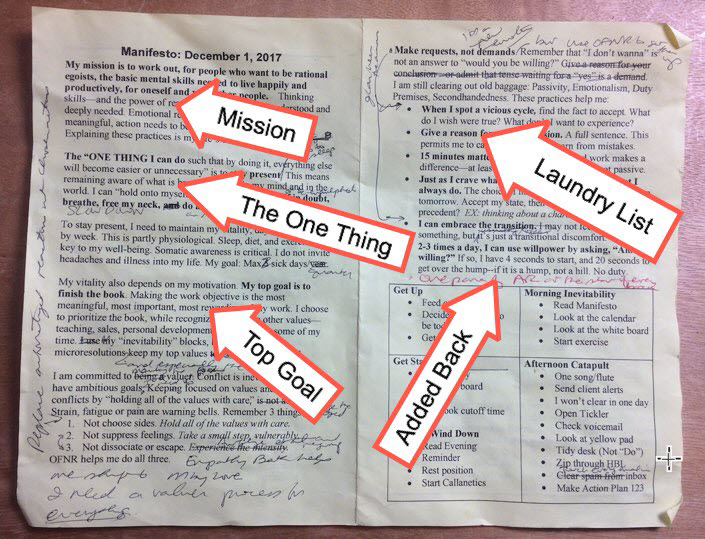Last week I gave a terrific class on how to troubleshoot “Rationally Connected Conversations.” I mentioned three mistakes to watch out for. Then yesterday in a conversation I made all three mistakes. Actually, I did catch mistake #1 at a certain point and remedy it. But it was only this morning that I realized I had also made mistakes #2 and #3.
Now, in fairness to me, in the class I had pointed out that one way you learn these skills is by making mistakes and taking a “do-over” after you figure that out. And I will, indeed, do a “do-over” of yesterday’s conversation.
But it remains that I had great intentions for how to handle a difficult conversation — and I forgot all about them in the actual situation.
This is not an isolated problem. It’s the essential problem of self-improvement. If you are trying to change ingrained habits, the most likely failure mode is that you will not notice the opportunity to act differently, or you will not remember any different action to take. Rather, your old, automatized responses will seem natural, obvious.
Habits die hard.
A practice I use to help me with this problem is to write — and read every day — a manifesto. It’s a statement of my intentions — my self-improvement intentions — with reminders of the practices I am learning to make second nature.
Here’s a picture of my current manifesto sheet with a few pieces marked:

You can see it’s not long -— about 500 words. It’s short enough I can read every day, which I do. You may notice it’s a little crumpled and marked up. That’s because it is a work in progress.
Let me go through the various items I’ve marked to give you an idea of what’s on it.
The first arrow points to my mission, which I’m happy to share:
My mission is to work out, for people who want to be rational egoists, the basic mental skills needed to live happily and productively, for oneself and with other people. Thinking skills — and the power of reason — are radically misunderstood and deeply needed. Emotional resilience is sorely lacking. To be meaningful, action needs to be integrated by a central purpose. Explaining these practices is my life’s calling.
I’ve sometimes started with my top goals, but since I clarified my mission about six months ago, that has been the lead.
The second arrow points to a paragraph which starts: “The one thing I can do such that by doing it, everything else will become easier or unnecessary is…” This I got from Gary Keller’s book, “The One Thing.” I had something like this in previous manifestos, but when I read Keller’s book last spring, I adopted his language to help me focus on the fundamental change I am trying to make.
This is an example of using my manifesto to learn a new practice. It turns out it’s difficult to figure out your “one thing.” I originally thought that my “one thing” was my book, but that is not quite right. After reading the statement every day for six months, I could see that attitude was distorting my perspective.
I moved my book to the section marked “top goal,” and added this sentence: “I choose to prioritize the book, while recognizing there are other values — teaching, sales, personal development — that warrant some of my time.
I’m still working out what my “one thing” is. In the current manifesto, I have it as “to stay present.” This is an excellent intention, but it is not clear enough to actually help me in the trenches of everyday life. For example, it didn’t help me avoid making the three mistakes I told you about earlier. So, I’m sure my “one thing” will evolve. I will mull on it briefly every day, and eventually I will figure out some advice that would be more helpful to me.
On the second page, you see an arrow labeled “Laundry List.” This is a series of practices and conclusions that I have decided to make second nature — but I still need to review them to remember them.
For example, some time ago I wrote about the 4-second rule, which I got from Peter Bregman. I have found it’s extremely helpful to remind myself that once I have a decision, I have 4 seconds to start acting — and I need to keep the action going for at least 20 seconds — or else the decision may just float away. This was a new idea to me when I first added it to my sheet some years ago. Now it is almost second nature to me, and I bet it will be dropped from the sheet in another six months, to make way for some new practice.
Finally, you can see the last arrow points to something added back, which is handwritten in red: “One para of AR [the author, Ayn Rand] at the start of every break.”
People often ask me how to remember all of the tactics I develop. The answer is, sometimes I don’t. While reading one of my old blog posts recently, I saw a mention about my reading a paragraph of Ayn Rand at the beginning of the break. I used to do that. That practice used to be listed on my manifesto. But I dropped it from my manifesto a while ago — and forgot about it!
It seemed like timely advice, so, I resurrected the method, tried it out, and thought more about it. I also thought about why it didn’t stick the last time. My best explanation is that I didn’t have a clear enough understanding of why it worked. Happily, I got much clearer on that while writing the last newsletter. This is what will go on the next typed version of the manifesto:
Start a break with 1 paragraph of AR to wake me up. I’ll see if I need rest, stimulation, recreation, or reflection.
* * *
I hope you can see that my manifesto is a living document. My intention in reading it is to hold my top values in mind — but forming values is not a passive process. I read what I wrote critically every day — and often find something that isn’t quite right, or is not relevant or needs to be added. About once a quarter I get bored by what I’ve written — it sounds stale — so I take an hour and rewrite the whole thing, in as inspirational a way as I can — reflecting my current top priorities.
I have been writing and reading my own manifesto for at least 8 years. Over that time, I have automatized many best practices and learned much about what works and doesn’t work for me. A manifesto is a simple investment of time as part of a daily routine, but it pays large dividends in the long-run.









0 Comments